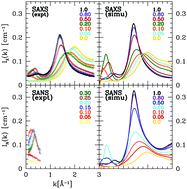Microscopic origin of the scattering pre-peak in aqueous propylamine mixtures: X-ray and neutron experiments versus simulations
Abstract
The structure of aqueous propylamine mixtures is investigated through X-ray and neutron scattering experiments, and the scattered intensities compared with computer simulation data. Both sets of data show a prominent scattering pre-peak, which first appears at propylamine mole fraction x ≥ 0.1 around scattering vector k ≈ 0.2 Å−1, and evolves towards k ≈ 0.8 Å−1 for neat propylamine x = 1. The existence of a scattering pre-peak in this mixture is unexpected, specifically in view of its absence in aqueous 1-propanol or aqueous DMSO mixtures. The detailed analysis of the various atom–atom structure factors and snapshots indicates that significant micro-structures exist, which produces correlation pre-peaks in the atom–atom structure factors, positive for like species atom correlations and negative for cross species correlations. The scattering pre-peak depends on how these two contributions cancel out or not. The way the amine group bonds with water produces a pre-peak through an imbalance of the positive and negative scattering contributions, unlike 1-propanol and DMSO, where these 2 contributions compensate exactly. Hence molecular simulations demonstrate how chemical details influence the microscopic segregation in different types of molecular emulsions and can be detected or not by scattering experiments.



 Please wait while we load your content...
Please wait while we load your content...